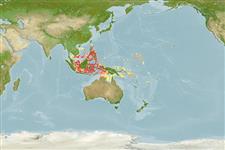>
Ovalentaria/misc (Various families in series Ovalentaria) >
Plesiopidae (Roundheads) > Acanthoclininae
Etymology: Acanthoplesiops: Greek, akantha = thorn + Greek, plesios = near + Greek, ops = similar (Ref. 45335).
Environment: milieu / climate zone / depth range / distribution range
Ecología
marino; rango de profundidad 8 - 34 m (Ref. 90102). Tropical
Western Pacific: the Philippines and Indonesia.
Tamaño / Peso / Age
Maturity: Lm ? range ? - ? cm
Max length : 4.0 cm TL macho / no sexado; (Ref. 48635)
Espinas dorsales (total) : 19 - 20; Radios blandos dorsales (total) : 5 - 6; Espinas anales: 8; Radios blandos anales: 6. Pale cream and distinctively marked with black banding over the top, anal fin and a vertical band on the caudal fin base (Ref. 48635).
Secretive in sheltered reefs to about 20 m depth (Ref. 48635); a few species collected from reef crevices in 8-34 m (Ref 90102). Eggs are guarded by the male parent (Ref. 205).
Life cycle and mating behavior
Maturities | Reproducción | Spawnings | Egg(s) | Fecundities | Larva
Eggs are guarded by the male parent (Ref. 205).
Mooi, R.D., 1999. Plesiopidae. Roundheads (prettyfins, longfins). p. 2578-2585. In K.E. Carpenter and V.H. Niem (eds.) FAO species identification guide for fishery purposes. The living marine resources of the WCP. Vol. 4. Bony fishes part 2 (Mugilidae to Carangidae). FAO, Rome. (Ref. 12926)
IUCN Red List Status (Ref. 130435)
Threat to humans
Harmless
Human uses
Herramientas
Special reports
Download XML
Fuentes de Internet
Estimates based on models
Preferred temperature (Ref.
123201): 28 - 29.1, mean 28.5 °C (based on 44 cells).
Phylogenetic diversity index (Ref.
82804): PD
50 = 0.5156 [Uniqueness, from 0.5 = low to 2.0 = high].
Bayesian length-weight: a=0.00457 (0.00180 - 0.01158), b=3.10 (2.87 - 3.33), in cm total length, based on LWR estimates for this (Sub)family-body shape (Ref.
93245).
Nivel trófico (Ref.
69278): 3.6 ±0.59 se; based on food items.
Resiliencia (Ref.
120179): Alto, población duplicada en un tiempo mínimo inferior a 15 meses (Preliminary K or Fecundity.).
Fishing Vulnerability (Ref.
59153): Low vulnerability (10 of 100).
